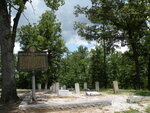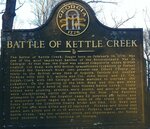

On a winter Sunday morning in February 1779, the sound of gunfire broke the silence along the marshy bottom at the juncture of two small creeks in Wilkes County, Georgia, as men engaged in a life and death struggle. The Battle of Kettle Creek, a pivotal battle and one of the few patriot victories in Georgia, had begun.
Tories (Georgians loyal to the crown) called that area “The Hornets’ Nest” during the American Revolution. Most Baptists belonging to the seven small Baptist churches in the colony during the American Revolution simply called Wilkes and neighboring Richmond County “home.”
At Kettle Creek, local Baptists fell in line to defend their homes, their families, and, by their very presence, cast a vote for religious freedom. At the juncture of two small creeks, 340 members of the South Carolina and Georgia militias faced a superior force of 600 Tories.
So, who were these families making up the hornets’ nest? What was their story?
The families living in Wilkes and Richmond counties had primarily migrated from Virginia and the Carolinas. They were poor subsistence farmers simply seeking to provide for their families.
Many of them had arrived in a wave from North Carolina in 1771-1772 in the aftermath of the Battle of Alamance. This battle took place when North Carolina Governor Tryon sent troops to put down protest over his use of taxes for personal projects, the enrichment of his cronies and abuse of the judicial system. Those arriving included Baptists and Quakers whom Governor Tryon had erroneously identified with the protestors. The governor had previously demonstrated his disdain for Baptist preachers by calling them “strollers,” a derogatory name used for “peddlers.”
By contrast, those living in the counties nearer the coast were more likely to include Tories who were more recent arrivals from Great Brittan. The Big Buckhead Baptist Church in Burke County was the easternmost of the seven congregations in Georgia and its membership was primarily composed of Tories. It was the only Baptist Church in Georgia that did not survive the Revolution as few Tories remained in Georgia following the war.
Baptist historian Morgan Edwards visited Alamance, N.C., the year after the battle in 1772. He recorded the devastating consequences of the persecution on the Sandy Creek Baptist Church, located 20 miles from Alamance. “The cause of this dispersion was the abuse of power which too much prevailed in the providence and caused the inhabitants at last to rise up in arms, and fight for their privileges; but being routed, May 16, 1771, they despaired of seeing better times, and therefore quitted the providence. It is said 1,500 families departed since the battle of Alamance, and, to my knowledge, a great many more are only waiting to dispose of their plantations, to follow them.” (Materials towards a history of the Baptists in the provinces of Maryland, Virginia, North Carolina, South Carolina, Georgia p. 146). Within a few years, the Sandy Creek Church, which had more than 600 members, was reduced to a membership of 17.
So, the “hornets” living in Wilkes County included Baptist religious refugees who had not raised arms against the crown but had been unjustly persecuted as if they had. They were humble farmers who had to abandon their farms where they had invested years of their lives clearing timber, plowing and tending the soil, building cabins and barns. They were then forced to make the long journey to Georgia with their families. They must have been difficult steps to take, but as it turns out, they were steps on the road to religious freedom.
After the war began in 1775, Baptists from Georgia served in the local militias and regular Continental Line. Georgia Baptist ministers accounted for 6 of the 12 chaplains serving the Georgia militias. By the end of the war most Baptist pastors, except for the aged Daniel Marshall, were forced to flee the state with their families. Pastors were targeted by the Tories because of the leadership they provided in Georgia’s backwoods communities.
The names of most of the Georgia militia who fought at Kettle Creek have been lost to time but, among those that are recorded, there are a few who identified as Baptists.
Private Jacob Mercer was the brother of Chaplain Silas Mercer and the uncle of Rev. Jesse Mercer, he is buried in the Providence Baptist Cemetery, Shady Dale, Georgia.
Private Peter Strozier, born in 1748 in Germany, came with his family to America as a young child. He is buried in Sardis Baptist Church Cemetery, Wilkes County, Georgia.
Captain James Cartledge was the brother of the infamous Rev. Samuel Cartledge. The latter arrested Baptist pioneer preacher Daniel Marshall in 1771 for “preaching in the Parish of Saint Paul without a license.” In a Damascus Road turn of events, Samuel Cartlidge was later saved and baptized by Marshall. Both brothers served in the Revolution and are buried in the family cemetery in Wilkes County.
Rev. Samuel Whatley was baptized by Silas Mercer and a member of the Phillips Mill Baptist Church in Wilkes County. Whatley's Revolutionary War experiences are summarized by Jesse Campbell in Georgia Baptist Historical and Biographical. “Having been once almost drowned, twice frozen, twice shot and once hung," Campbell writes, "he survived to enjoy the blessings of liberty and to a good old age.” Whatley was active in ministry in the Georgia Baptist Association and is buried at the Phillips Mill Baptist Church where he was a member for more than 40 years.
As we celebrate the birth of our nation in the coming days, it is important to remember that many who rallied to arms did so with the call for religious freedom ringing in their ears. They came from places like “the Hornet’s Nest” in Wilkes County. They came from the pulpits of small Baptist churches. They were humble laypeople rising from their knees off the hardwood pine floors of rural meeting houses who sought to worship according to the dictates of their conscience without fear of repression. By their actions and deeds, they were a part of the collective cry for freedom which led to the birth of the nation. Their sacrifices for the cause of religious freedom should never be forgotten, diminished or dismissed.